Immigration as a Divisive Topic: Clusters and Content Diffusion in the Italian Twitter Debate
Abstract
1. Introduction
- People engaged in a divisive debate are not necessarily influenced by external factors (as already pointed out in [7]) or also ‘facts’ and observable events.
- The presence of clusters with heterogeneous characterisation in the Twitter network can represent a more diversified manifestation of the so-called ‘echo-chamber’ phenomenon.
- Where are the users tweeting about immigration located? We know that certain areas are more exposed to the presence of both regular and irregular migrants: regions of arrival, big cities [16], transition regions towards central Europe. Are we able to locate Twitter users posting about migrants? Is there a geographical correlation with the location of migrants, i.e., are people talking about migration where the issue is more pressing, or is it more of a national debate untied from local observable events?
- How do interactions between users with different opinions unfold? A structural study of the interaction among users discussing about the topic of migration could help us to understand the extent and dynamics of the public debate on social media. Is it really a strongly divisive topic? Who are the actors driving the debate, and are we able to identify factions with different stances? Is the size of such clusters somehow proportional to the popularity of their leaders?
- What is the role of clusters in the diffusion of opinions and news? Given that the migration debate network on Twitter is divided in many clusters, we wonder how opinions and news shared within those groups of accounts spread to other communities. Do locally popular news have the chance to get also distant clusters? Do a cluster play a role as a barrier or an accelerator of diffusion?
1.1. Paper’s Structure Road Map
1.2. Related Work
2. Data
Twitter Data Collection and Pre-Processing
3. Methods and Results
3.1. Where Are the Users Located? Geo-Spatial Analysis
3.1.1. Geolocation of Tweets
- If geotagged information is present (coordinates detected by the Twitter client, if access to the geolocation of the device was granted by the user), this will be the preferred information.
- Otherwise, if the user checked-in a place when posting the tweet, this information will be used.
- Finally, we would look if the user set a home location in his/her profile.
3.1.2. Correlation with Institutional Spatial Data
3.2. How Do They Interact? Analysis of the RT Network
- RT network: each node is a Twitter user, and a link is established between two nodes if one of the users retweets or quotes the other. The link is weighted, with the weight representing the number of RTs and quotes between the two users.
- Reply network: each node is a Twitter user, and a link is established between two nodes if one of the users replies to the other. Here as well, the weight is the number of replies between the two.
- Mention network: each node is a Twitter user, and a link is established between two nodes if one of the users mentions the other. The same weighting mechanism applies to this network.
3.2.1. Community Structure and Analysis of Content: Polarisation of the Debate
3.2.2. Characterisation of the Communities: Hashtags and N-Grams
3.3. Quantifying the Diversity among Communities: Analysis of Shared URLs
4. Discussion
5. Conclusions and Future Work
- We focused on the interactions between the five biggest communities, covering 87% of the nodes and leaving 29,969 out of the analysis. These remaining nodes gather in very small groups to form hundreds of micro-communities; therefore, it is harder for us to infer their stance towards migration as we did with the bigger clusters. Still, this does not necessarily mean that they do not play an important role in the debate. These nodes could be seen as the undecided—in our network they struggle to take a stance—and literature tells us that their role is often non trivial. Indeed, in [22], the authors find that anti-vaccination clusters are smaller numerically but are more central than others in terms of their positioning within the network, similarly to the behaviour of our clusters RT3 and RT4. They also find that the undecided are far from being passive. They are instead highly active and, with the system evolving, they get more and more entangled with the anti-vaxers, i.e., most central groups that, while being a minority, manage to make a better use of the social media tool. Therefore our 29,969 undecided nodes, which are not taken into account in the present work, are worth being further explored, especially within the context of an evolving, rather than static, network of interactions.
- Both the community-wise hashtag and uni-grams analyses do not yield significant differences. This is partly because the topic is already filtered, specific and well defined, so there is not a large variety of hashtags; furthermore, the hashtag are strongly influenced by the external events, which we usually refer to with the same hashtag regardless of our stance towards them. Therefore, in this specific case, hashtags alone can hardly be used for topic or stance detection.
- Finally, we must remember that, even though we have more than 6 M tweets, we are still studying a restricted sample if compared to the true national debate. There is a number of biases that must be taken into account when dealing with social media data, first and foremost the fact that the population of users is most likely biased towards a certain socio-demographic cohort, as well as the fact that the behaviour of people on social media does not necessarily reflect their behaviour and ideas in “real life”, especially when it comes to such delicate matters.
Author Contributions
Funding
Conflicts of Interest
Abbreviations
| FdI | Fratelli d’Italia—Brothers of Italy |
| FI | Forza Italia—Go Italy |
| Lega | League—formerly known as Northern League |
| LeU | Liberi e Uguali—Free and Equal |
| M5S | Movimento 5 Stelle—5 Stars Movement |
| PD | Partito Democratico—Democratic Party |
| RT | Retweet |
Appendix A. URLs Basic Statistics
| ID | Number of URLs |
|---|---|
| RT1 | 16,659 |
| RT2 | 15,573 |
| RT3 | 4386 |
| RT4 | 5424 |
| RT5 | 6224 |
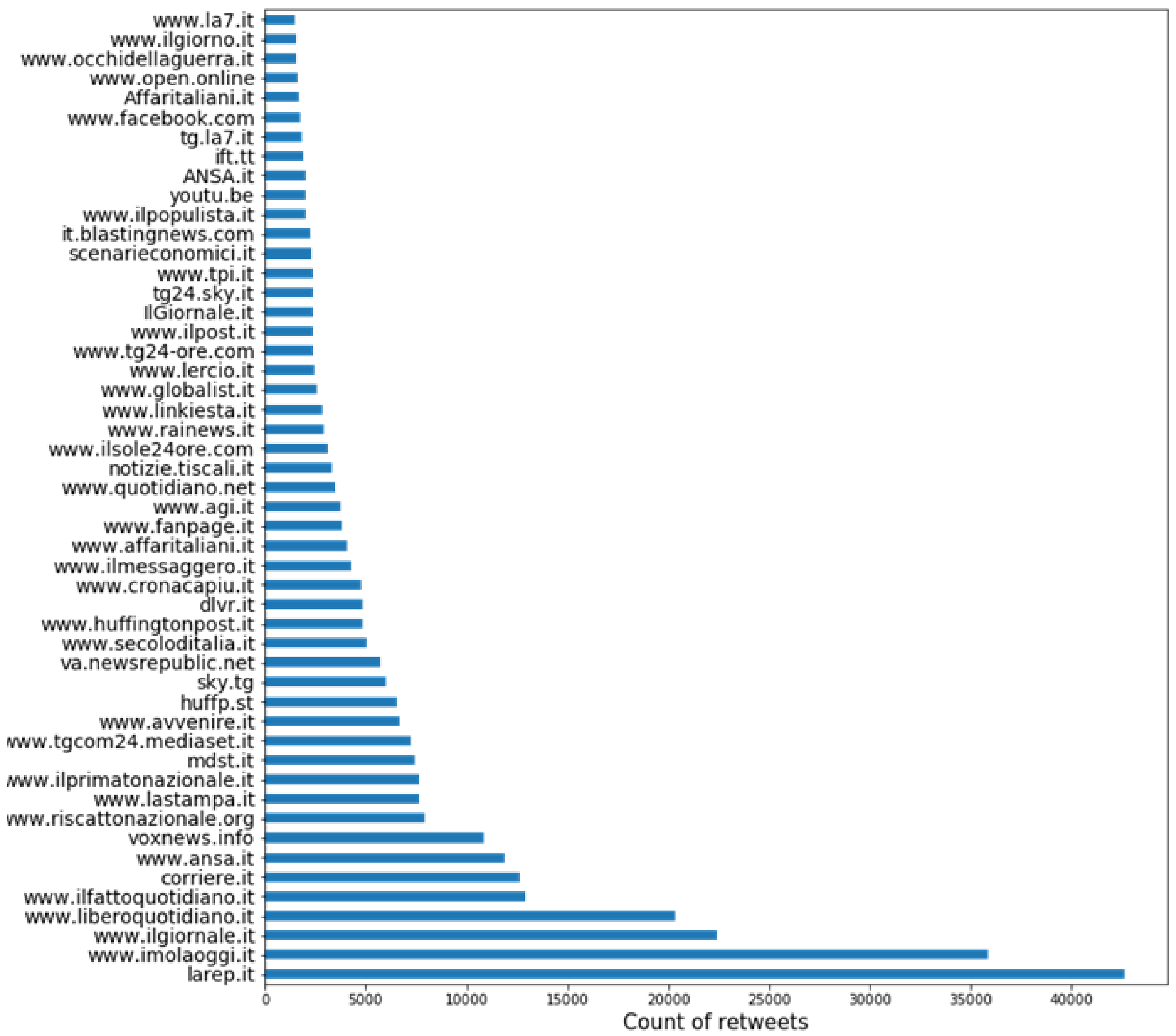
References
- Eurostat. Eurostat Report on Migrants 2017. Available online: https://ec.europa.eu/eurostat/documents/3217494/8787947/KS-05-17-100-EN-N.pdf/f6c45af2-6c4f-4ca0-b547-d25e6ef9c359 (accessed on 12 October 2020).
- Pasini, N.; Biassoni, D. L’immigrazione nel Dibattito Politico Italiano; FrancoAngeli: Milan, Italy, 2014; p. 11. [Google Scholar]
- El-Ibiary, R.; Rabrenovic, A.; Polje, B.; Maronitis, K. Laura Alonso-Muñoz* and Andreu Casero-Ripollés. Available online: https://www.frontiersin.org/articles/10.3389/fcomm.2020.00054/full (accessed on 12 October 2020).
- Kingsley, P. Migration to Europe Is Down Sharply. So Is It Still a ‘Crisis’? The New York Times, 27 June 2018. [Google Scholar]
- Caiani, M. The populist parties and their electoral success: Different causes behind different populisms? The case of the Five-star Movement and the League. Contemp. Ital. Politics 2019, 11, 236–250. [Google Scholar] [CrossRef]
- Diehl, T.; Weeks, B.E.; de Zuniga, H.G. Political persuasion on social media: Tracing direct and indirect effects of news use and social interaction. New Media Soc. 2016, 18, 1875–1895. [Google Scholar] [CrossRef]
- Zheng, P.; Shahin, S. Live tweeting live debates: How Twitter reflects and refracts the US political climate in a campaign season. Inf. Commun. Soc. 2020, 23, 337–357. [Google Scholar] [CrossRef]
- Conover, M.D.; Ratkiewicz, J.; Francisco, M.; Gonçalves, B.; Menczer, F.; Flammini, A. Political polarization on twitter. In Proceedings of the Fifth International AAAI Conference on Weblogs and Social Media, Barcelona, Spain, 17–21 July 2011. [Google Scholar]
- Feller, A.; Kuhnert, M.; Sprenger, T.O.; Welpe, I.M. Divided they tweet: The network structure of political microbloggers and discussion topics. In Proceedings of the Fifth International AAAI Conference on Weblogs and Social Media, Barcelona, Spain, 17–21 July 2011. [Google Scholar]
- Adamic, L.A.; Glance, N. The political blogosphere and the 2004 US election: Divided they blog. In Proceedings of the 3rd International Workshop on Link Discovery, Chicago, IL, USA, 21–25 August 2005; pp. 36–43. [Google Scholar]
- Lai, M.; Tambuscio, M.; Patti, V.; Ruffo, G.; Rosso, P. Stance polarity in political debates: A diachronic perspective of network homophily and conversations on Twitter. Data Knowl. Eng. 2019, 124, 101738. [Google Scholar] [CrossRef]
- Cossard, A.; Morales, G.D.F.; Kalimeri, K.; Mejova, Y.; Paolotti, D.; Starnini, M. Falling into the echo chamber: The italian vaccination debate on twitter. arXiv 2020, arXiv:2003.11906. [Google Scholar]
- Centola, D. The spread of behavior in an online social network experiment. Science 2010, 329, 1194–1197. [Google Scholar] [CrossRef] [PubMed]
- Centola, D.; Macy, M. Complex contagions and the weakness of long ties. Am. J. Sociol. 2007, 113, 702–734. [Google Scholar] [CrossRef]
- Tambuscio, M.; Oliveira, D.F.; Ciampaglia, G.L.; Ruffo, G. Network segregation in a model of misinformation and fact-checking. J. Comput. Soc. Sci. 2018, 1, 261–275. [Google Scholar] [CrossRef]
- Lamanna, F.; Lenormand, M.; Salas-Olmedo, M.H.; Romanillos, G.; Gonçalves, B.; Ramasco, J.J. Immigrant community integration in world cities. PLoS ONE 2018, 13, e0191612. [Google Scholar] [CrossRef]
- McMahon, S. The politics of immigration during an economic crisis: Analysing political debate on immigration in Southern Europe. J. Ethnic Migr. Stud. 2018, 44, 2415–2434. [Google Scholar] [CrossRef]
- Public Opinion on Migration. Migration Data Portal, IOM. Available online: https://migrationdataportal.org/themes/public-opinion-migration (accessed on 4 November 2019).
- Koch, C.M.; Moise, I.; Helbing, D.; Donnay, K. Public debate in the media matters: Evidence from the European refugee crisis. EPJ Data Sci. 2020, 9, 1–27. [Google Scholar] [CrossRef]
- Mora-Cantallops, M.; Sánchez-Alonso, S.; Visvizi, A. The influence of external political events on social networks: The case of the Brexit Twitter Network. J. Ambient Intell. Humaniz. Comput. 2019, 1–13. [Google Scholar] [CrossRef]
- Colleoni, E.; Rozza, A.; Arvidsson, A. Echo chamber or public sphere? Predicting political orientation and measuring political homophily in Twitter using big data. J. Commun. 2014, 64, 317–332. [Google Scholar] [CrossRef]
- Johnson, N.F.; Velásquez, N.; Restrepo, N.J.; Leahy, R.; Gabriel, N.; El Oud, S.; Zheng, M.; Manrique, P.; Wuchty, S.; Lupu, Y. The online competition between pro-and anti-vaccination views. Nature 2020, 582, 230–233. [Google Scholar] [CrossRef] [PubMed]
- Hawelka, B.; Sitko, I.; Beinat, E.; Sobolevsky, S.; Kazakopoulos, P.; Ratti, C. Geo-located Twitter as proxy for global mobility patterns. Cartogr. Geogr. Inf. Sci. 2014, 41, 260–271. [Google Scholar] [CrossRef] [PubMed]
- Fiorio, L.; Abel, G.; Cai, J.; Zagheni, E.; Weber, I.; Vinué, G. Using Twitter data to estimate the relationship between short-term mobility and long-term migration. In Proceedings of the 2017 ACM on Web Science Conference, Troy, NY, USA, 25–28 June 2017; pp. 103–110. [Google Scholar]
- Zagheni, E.; Garimella, V.R.K.; Weber, I.; State, B. Inferring international and internal migration patterns from twitter data. In Proceedings of the 23rd International Conference on World Wide Web, Seoul, Korea, 7–11 April 2014; pp. 439–444. [Google Scholar]
- Hübl, F.; Cvetojevic, S.; Hochmair, H.; Paulus, G. Analyzing refugee migration patterns using geo-tagged tweets. ISPRS Int. J. Geo-Inf. 2017, 6, 302. [Google Scholar] [CrossRef]
- Bodrunova, S.S.; Litvinenko, A.A.; Gavra, D.P.; Yakunin, A.V. Twitter-based discourse on migrants in Russia: The case of 2013 bashings in Biryulyovo. Int. Rev. Manag. Mark. 2015, 5, 97–104. [Google Scholar]
- Bodrunova, S.S.; Litvinenko, A.A.; Blekanov, I.S. Comparing influencers: Activity vs. connectivity measures in defining key actors in Twitter ad hoc discussions on migrants in Germany and Russia. In International Conference on Social Informatics; Springer: Berlin/Heidelberg, Germany, 2017; pp. 360–376. [Google Scholar]
- Florio, K.; Basile, V.; Lai, M.; Patti, V. Leveraging Hate Speech Detection to Investigate Immigration-related Phenomena in Italy. In Proceedings of the 2019 8th International Conference on Affective Computing and Intelligent Interaction Workshops and Demos (ACIIW), Cambridge, UK, 3–6 September 2019; pp. 1–7. [Google Scholar]
- Kemp, S. Digital 2019: Italy. Available online: https://datareportal.com/reports/digital-2019-italy (accessed on 12 October 2020).
- Mencarini, L.; Farías, D.I.H.; Lai, M.; Patti, V.; Sulis, E.; Vignoli, D. Happy parents’ tweets: An exploration of Italian Twitter data using sentiment analysis. Demogr. Res. 2019, 40, 693–724. [Google Scholar] [CrossRef]
- Pastor-Satorras, R.; Vázquez, A.; Vespignani, A. Dynamical and correlation properties of the Internet. Phys. Rev. Lett. 2001, 87, 258701. [Google Scholar] [CrossRef]
- Marcos-García, S.; Alonso-Muñoz, L.; López-Meri, A. Extending influence on social media: The behaviour of political talk-show opinion leaders on Twitter. Commun. Soc. 2020, 33, 277–293. [Google Scholar] [CrossRef]
- Boyd, D.; Golder, S.; Lotan, G. Tweet, tweet, retweet: Conversational aspects of retweeting on twitter. In Proceedings of the 2010 43rd Hawaii International Conference on System Sciences, Honolulu, HI, USA, 5–8 January 2010; pp. 1–10. [Google Scholar]
- Blondel, V.D.; Guillaume, J.L.; Lambiotte, R.; Lefebvre, E. Fast unfolding of communities in large networks. J. Stat. Mech. Theory Exp. 2008, 2008, P10008. [Google Scholar] [CrossRef]
- Weng, L.; Menczer, F.; Ahn, Y.Y. Virality prediction and community structure in social networks. Sci. Rep. 2013, 3, 2522. [Google Scholar] [CrossRef] [PubMed]
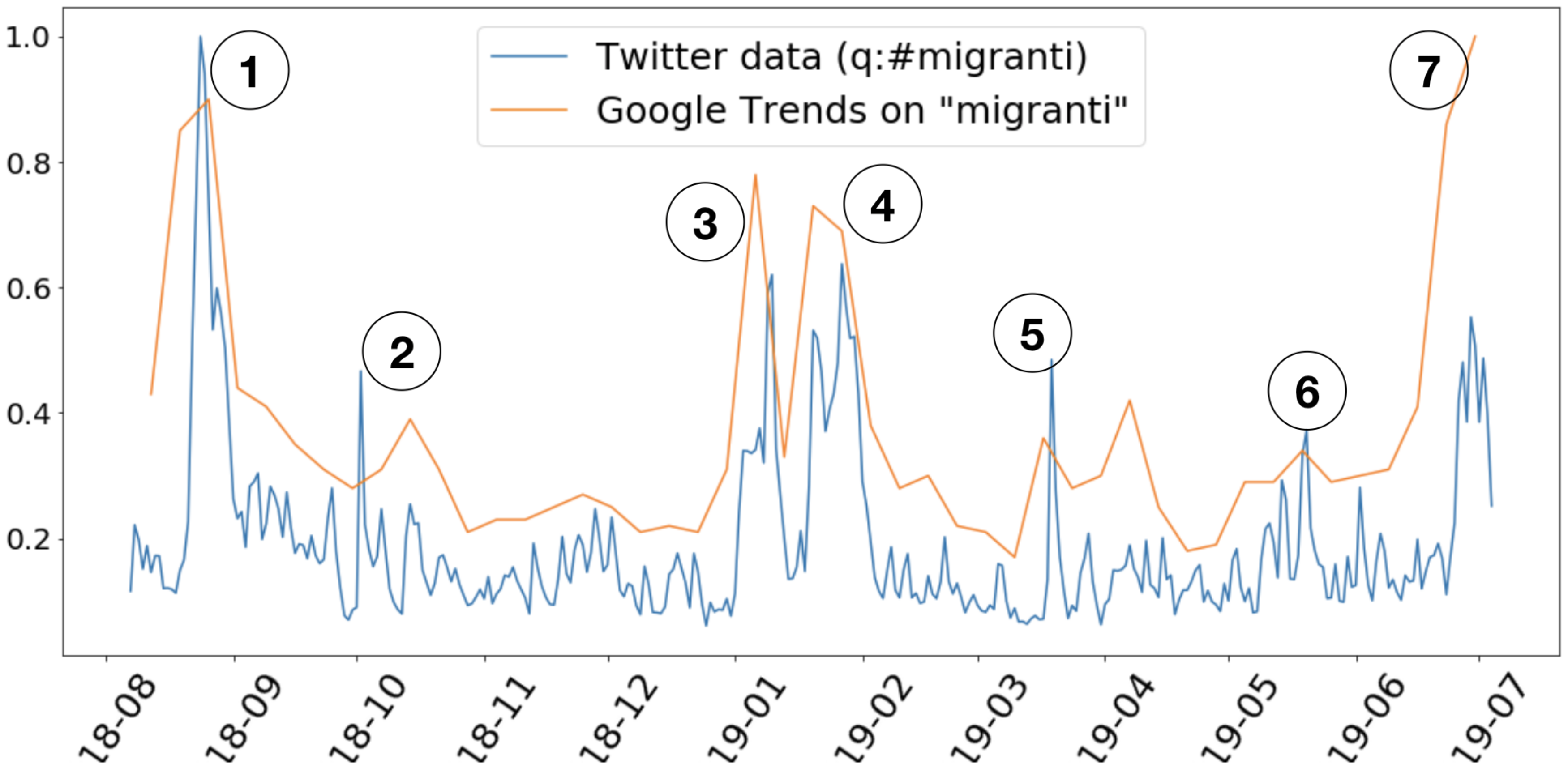
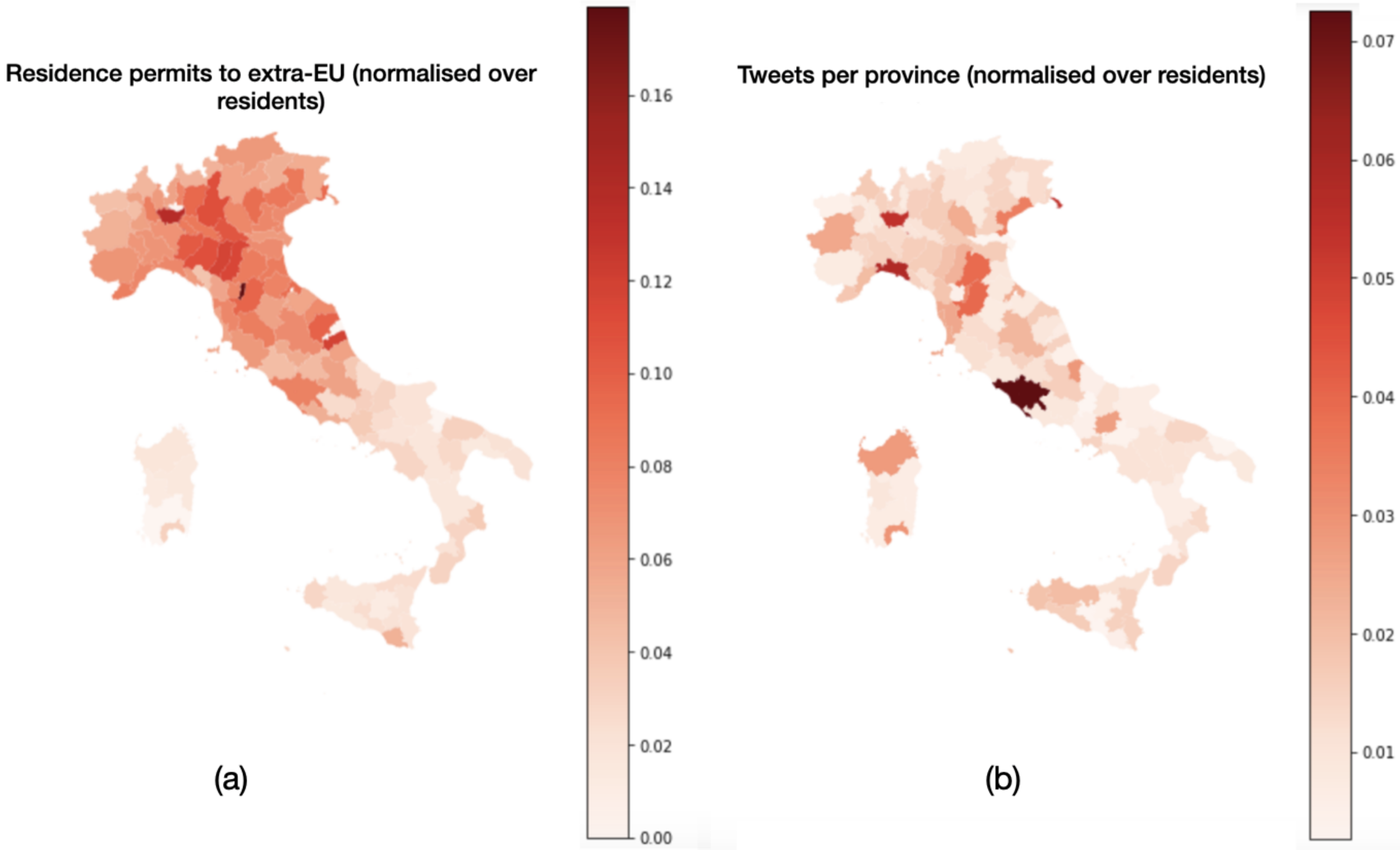
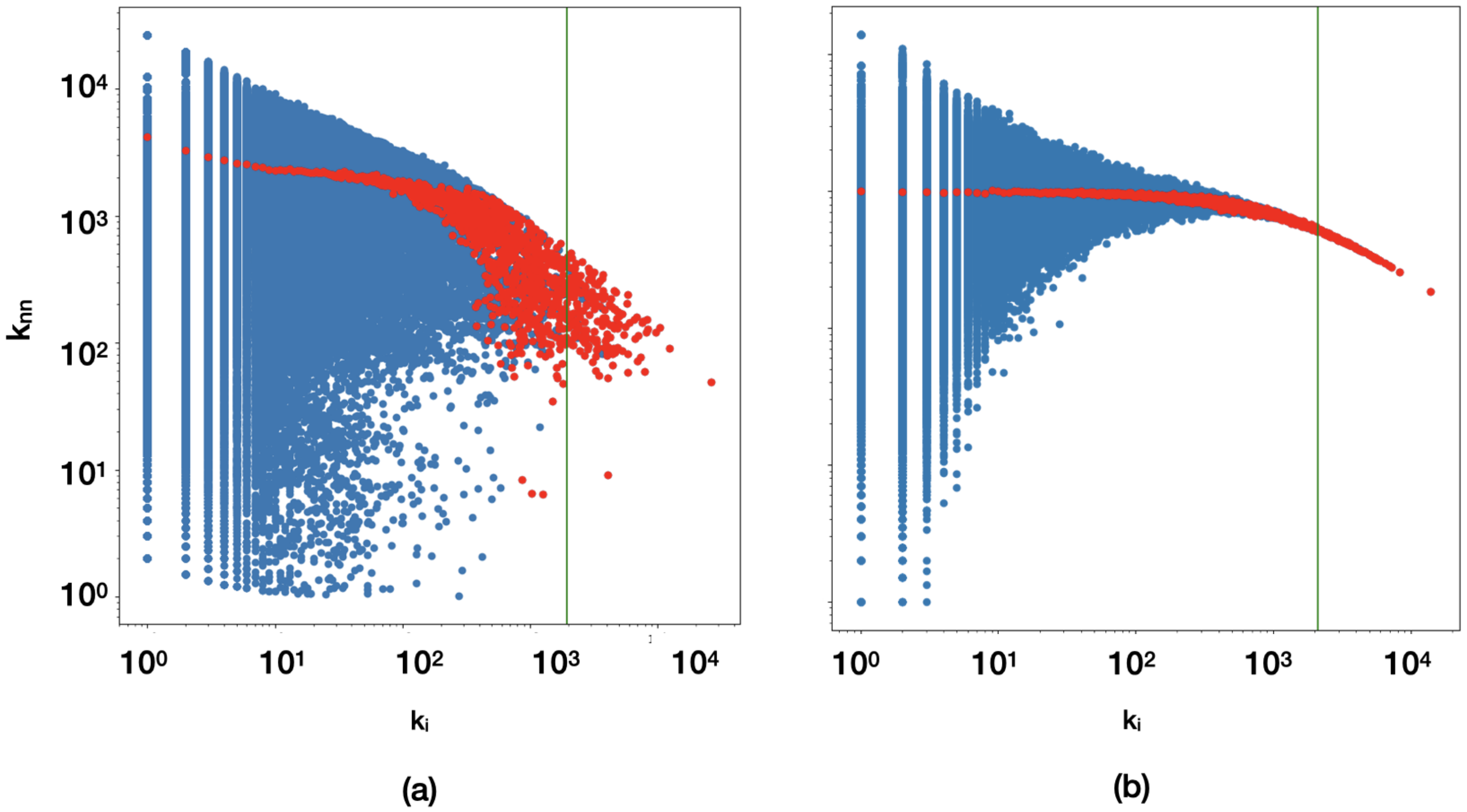

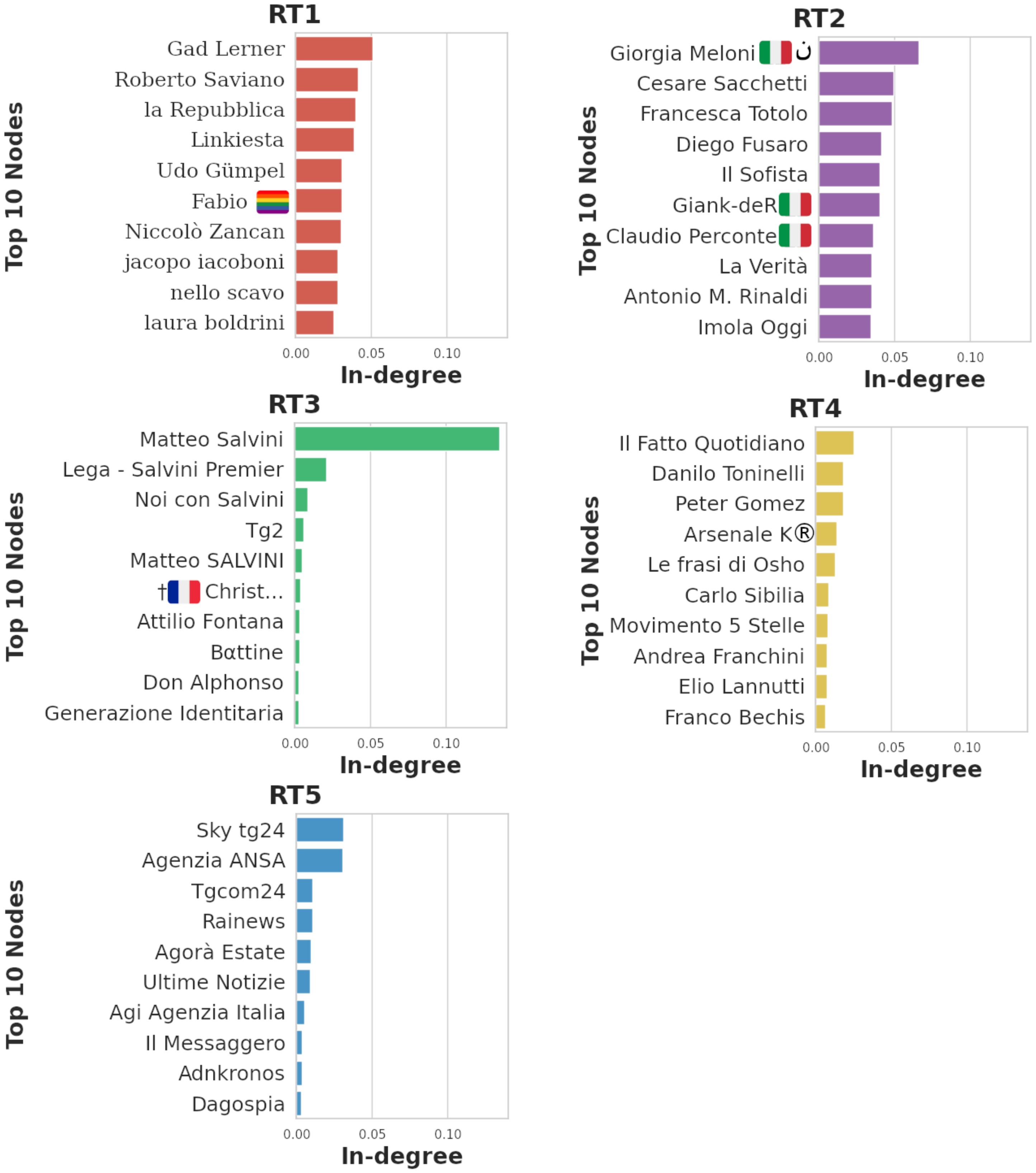
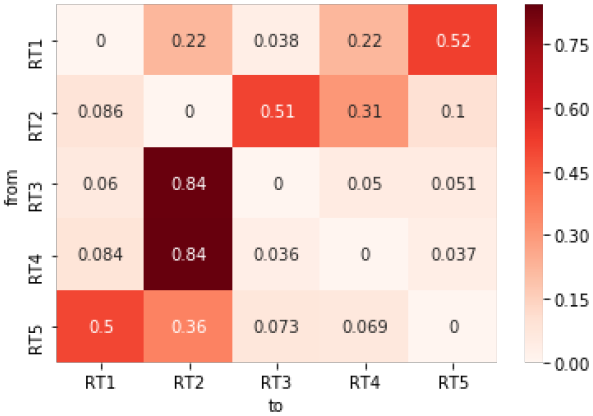
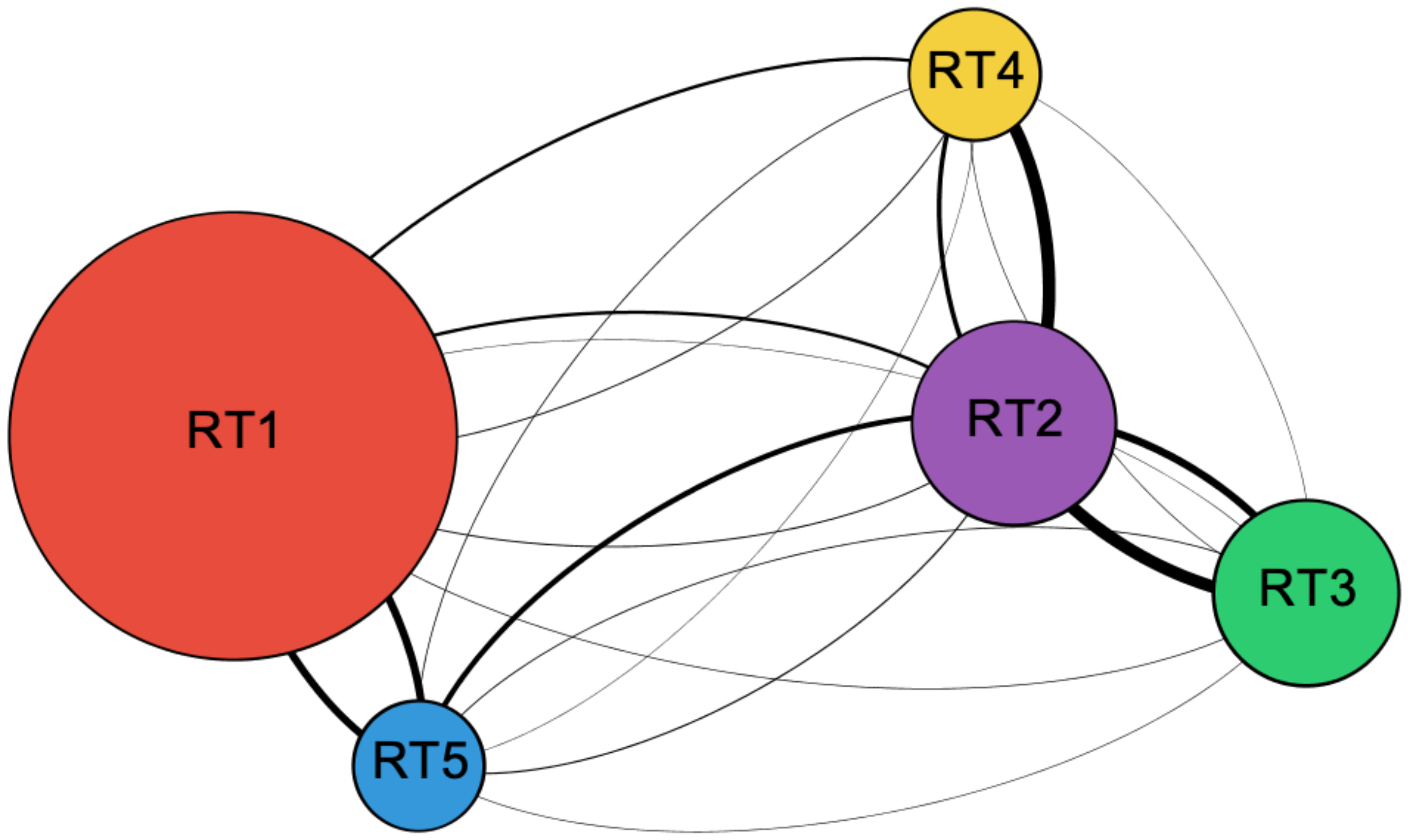
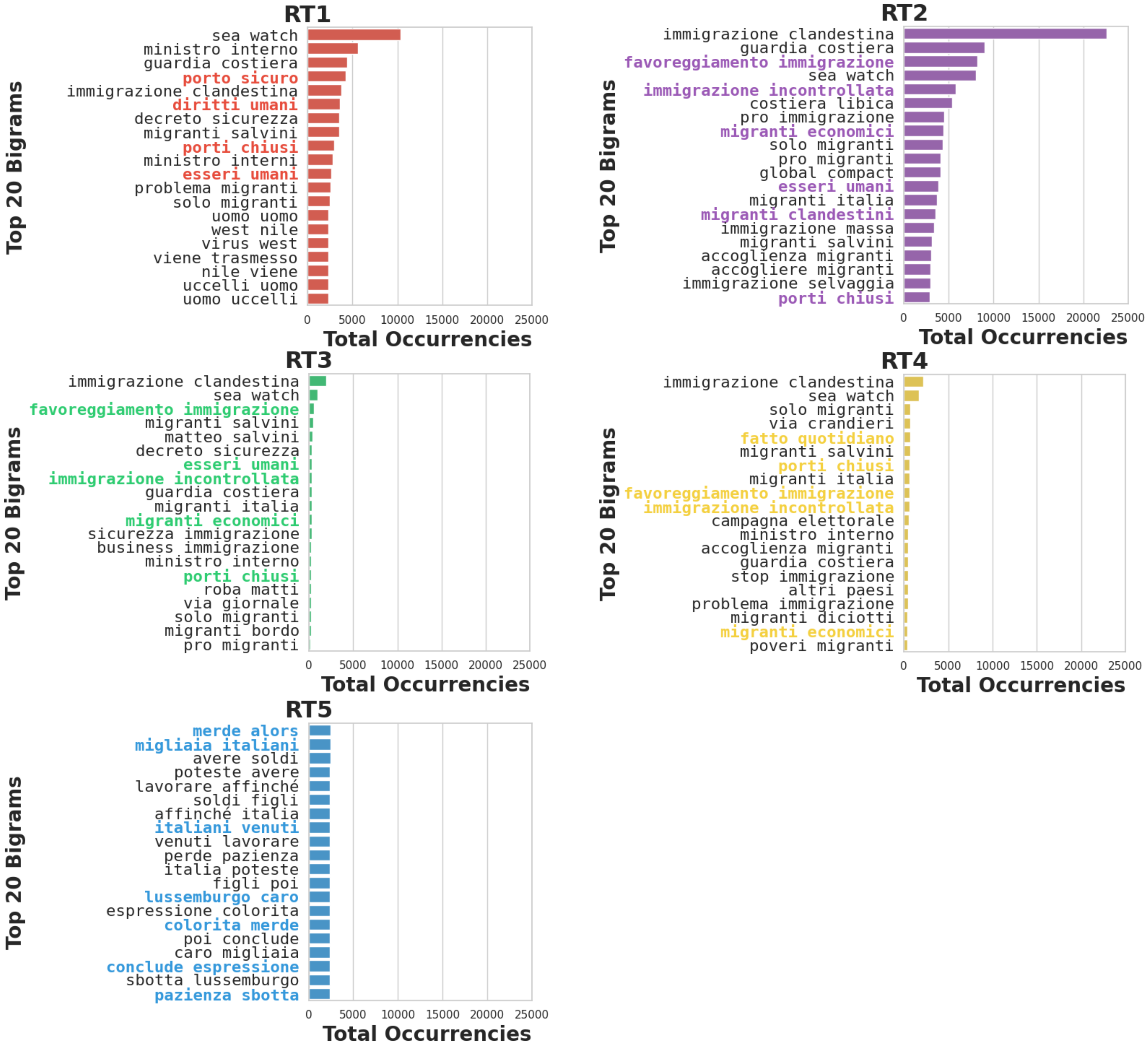


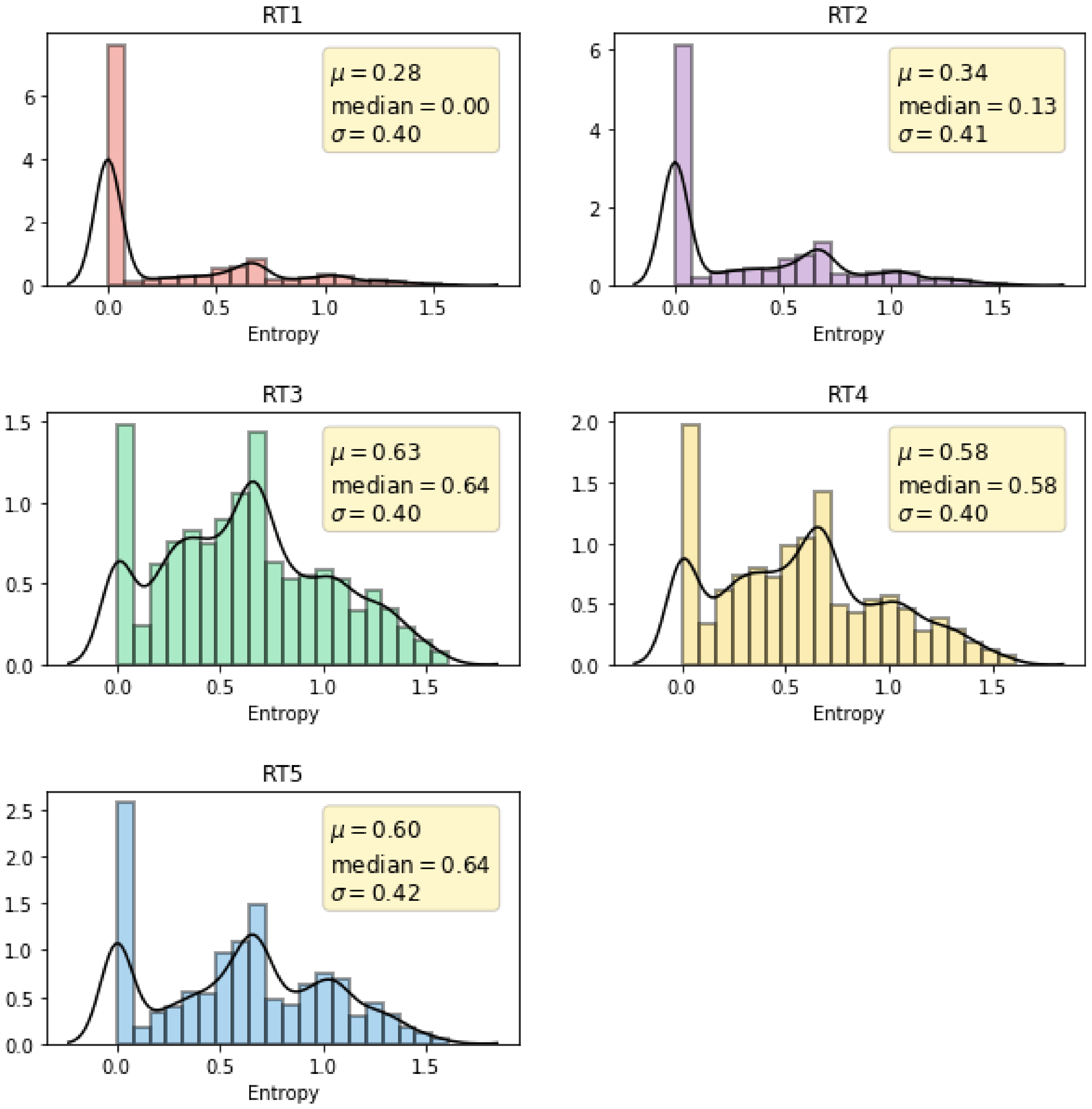
| Tweet | Meaning |
|---|---|
| Tweet | Original content posted by a user. A tweet can also include a mention to other users, or an URL pointing to an external website. |
| Mention | The act of mentioning another user, by citing their nickname after the ‘@’ symbol. |
| Retweet (RT) | Another user’s post, shared by the author of the retweet. |
| Quote | A retweet with an additional comment by the author of the retweet. |
| Reply | The act of replying to another user by clicking on “Reply” under the original tweet. The addressed user is mentioned with the ‘@’ symbol, at the beginning of the reply message. |
| Composition of the Twitter Dataset | |
|---|---|
| Retweets | 4,424,359 |
| Quotes | 1,029,317 |
| Replies | 402,177 |
| RT Network | Reply Network | Mention Network | |
|---|---|---|---|
| Number of nodes | 232,384 | 75,319 | 130,202 |
| Number of links | 2,210,242 | 280,318 | 770,505 |
| Density | |||
| Size of Giant Component | 227,597 | 75,319 | 130,202 |
| Modularity | 0.48 | 0.44 | 0.25 |
| ID | Size | Internal Link Density | No. of #Migranti | Highest In-Degree Nodes (Usernames) | Top Hashtags |
|---|---|---|---|---|---|
| RT1 | 116,831 | 51,639 | Gad Lerner, Roberto Saviano, La Repubblica, Linkiesta, Udo Gümpel, Fabio Niccolò Zancan, jacopo iacoboni, Nello Scavo, laura boldrini. | #salvini, #diciotti, #facciamorete, #immigrazione, #seawatch, #pd, #ong, #italia, #riace, #restiamoumani | |
| RT2 | 34,174 | 62,980 | Giorgia Meloni, Cesare Sacchetti, Francesca Totolo, Diego Fusaro, La Verità, ImolaOggi, Giank-deR, Claudio Perconte, Il Sofista, Antonio M. Rinaldi. | #salvini, #immigrazione, #diciotti, #seawatch, #libia, #facciamorete, #riace #lega, #portichiusi, #salvininonmollare | |
| RT3 | 27,845 | 4575 | Matteo Salvini, Lega - M. Salvini Premier, Noi con Salvini, TG2, Attilio Fontana, Generazione Identitaria, Marco Morini, Cittadina Italiana, Don Alphonso, Matteo SALVINI | #salvini, #diciotti, #immigrazione, #pd, #libia, #italia, #ong, #decretosalvini, #salvininonmollare, #portichiusi | |
| RT4 | 9553 | 8887 | Il Fatto Quotidiano, Danilo Toninelli, Peter Gomez, Carlo Sibilia, Movimento 5 Stelle, Franco Bechis, Andrea Franchini, Le Frasi di Osho, Elio Lannutti. | #salvini, #diciotti, #immigrazione, #pd, #facciamorete, #m5s, #seawatch, #ong, #lega, #portichiusi, #dimaio | |
| RT5 | 9225 | 6193 | SkyTg24, ANSA, Tgcom24, RaiNews, Agorà Estate, Agi Agenzia Italia, Adkronos, Dagospia, Ultime Notizie, Il Messaggero. | #salvini, #diciotti, #immigrazione, #facciamorete, #allnews24, #seawatch, #dimaio, #AGI, #nonstopnews, #libia |
| ID | Bi-Grams (IT) | Bi-Grams (EN) |
|---|---|---|
| Common to all communities but RT5 | Sea Watch, Ministro Interno, Guardia Costiera, Immigrazione Clandestina, Migranti Italia, Migranti Salvini | Sea Watch, Ministry Interior, Coast Guard, Illegal Immigration, Migrants Italy, Migrants Salvini |
| ID | Bi-Grams (IT) | Bi-Grams (EN) |
|---|---|---|
| RT1 | Porto Sicuro, Porti Chiusi, Esseri Umani, Diritti Umani | Safe Harbor, Closed Harbors, Human Beings, Human Rights |
| RT2 | Favoreggiamento Immigrazione, Immigrazione Incontrollata, Migranti Economici, Migranti Clandestini, Esseri Umani | Abetment Immigration, Uncontrolled Immigration, Economic Migrants, Illegal Migrants, Human Beings |
| RT3 | Favoreggiamento Immigrazione, Immigrazione Incontrollata, Migranti Economici | Abetment Immigration, Uncontrolled Immigration, Economic Migrants, Illegal Migrants |
| RT4 | Favoreggiamento Immigrazione, Immigrazione Incontrollata, Migranti Economici, Fatto Quotidiano | Abetment Immigration, Uncontrolled Immigration, Economic Migrants, Illegal Migrants, Fatto Quotidiano (Italian newspaper) |
| RT5 | Merde Alors, Migliaia Italiani, Colorita Merde, Italiani Venuti, Conclude Espressione, Pazienza Sbotta, Lussemburgo Caro | Merde Alors (French), Thousands Italians, Colorful Merde, Italians Came, Ends Expression, Patience Snaps, Luxembourg Dear |
Publisher’s Note: MDPI stays neutral with regard to jurisdictional claims in published maps and institutional affiliations. |
© 2020 by the authors. Licensee MDPI, Basel, Switzerland. This article is an open access article distributed under the terms and conditions of the Creative Commons Attribution (CC BY) license (http://creativecommons.org/licenses/by/4.0/).
Share and Cite
Vilella, S.; Lai, M.; Paolotti, D.; Ruffo, G. Immigration as a Divisive Topic: Clusters and Content Diffusion in the Italian Twitter Debate. Future Internet 2020, 12, 173. https://doi.org/10.3390/fi12100173
Vilella S, Lai M, Paolotti D, Ruffo G. Immigration as a Divisive Topic: Clusters and Content Diffusion in the Italian Twitter Debate. Future Internet. 2020; 12(10):173. https://doi.org/10.3390/fi12100173
Chicago/Turabian StyleVilella, Salvatore, Mirko Lai, Daniela Paolotti, and Giancarlo Ruffo. 2020. "Immigration as a Divisive Topic: Clusters and Content Diffusion in the Italian Twitter Debate" Future Internet 12, no. 10: 173. https://doi.org/10.3390/fi12100173
APA StyleVilella, S., Lai, M., Paolotti, D., & Ruffo, G. (2020). Immigration as a Divisive Topic: Clusters and Content Diffusion in the Italian Twitter Debate. Future Internet, 12(10), 173. https://doi.org/10.3390/fi12100173






